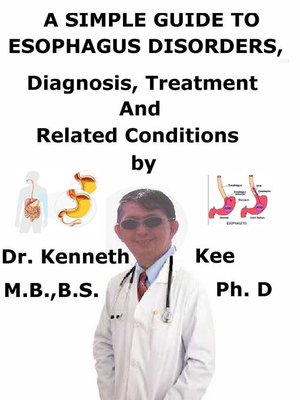A Simple Guide to Esophagus Disorders, Diagnosis, Treatment and Related Conditions
ebook
By Kenneth Kee

Sign up to save your library
With an OverDrive account, you can save your favorite libraries for at-a-glance information about availability. Find out more about OverDrive accounts.
Find this title in Libby, the library reading app by OverDrive.



Search for a digital library with this title
Title found at these libraries:
| Library Name | Distance |
|---|---|
| Loading... |
This book describes Esophagus Disorders, Diagnosis and Treatment and Related Diseases
The esophagus is the segment of the digestive tract that travels between the mouth and the stomach.
The esophagus is a tube with its primary function to carry food and liquid, after it has been ingested, from the mouth down into the stomach.
It takes only 10 seconds for food to move down the esophagus.
The esophagus is lined by moist pink tissue called mucosa and about 8 inches long.
The esophagus lies behind the windpipe (trachea) and heart and in front of the spine.
Before entering the stomach, the esophagus passes through a hole in the diaphragm.
The openings at the top of the esophagus at the back of the throat (UES) and at the bottom of the esophagus (LES) at the entrance to the stomach are closed off by muscles termed sphincters (called the upper esophageal sphincter and the lower esophageal sphincter).
The sphincters relax in order to let food and liquid pass through but then tighten again to prevent any materials from going up from the stomach into the esophagus and from the esophagus to the mouth.
The upper esophageal sphincter (UES) is a collection of muscles at the top of the esophagus.
The muscles of the UES are under voluntary control and are utilized when breathing, eating, belching, and vomiting.
They stop food and secretions from going down the windpipe (trachea).
The lower esophageal sphincter (LES) is a collection of muscles at the low end of the esophagus, where it enters the stomach.
When the LES is closed, it stops acid and stomach contents from going backwards from the stomach.
The LES muscles are not under conscious (voluntary) control.
Esophagus Disorders
An incompletely closed LES permits acidic stomach contents to back up (reflux) into the esophagus.
Reflux can produce heartburn, cough or hoarseness, or no symptoms at all.
When reflux happens often or is troublesome, it is called gastroesophageal reflux disease (GERD).
One fairly frequent disorder that can involve the esophagus is gastroesophageal reflux disease.
In GERD, the sphincter between the esophagus and the stomach grows weaker, which permits the food and digestive juices in the stomach to enter back into the esophagus.
Many people have an occasional short period of heartburn or indigestion, but GERD is diagnosed when reflux is happening more than 2 times per week.
Over time, GERD can result in more serious disorders such as an ulcer or strictures.
Inflammation of the esophagus is the reason behind esophagitis.
Esophagitis can be caused by irritation (as from reflux or radiation treatment) or infection.
Regular reflux of stomach acid causes irritation to the esophagus, which may induce the lower part to alter its structure.
Very rarely, Barrett's esophagus goes on to esophageal cancer.
Similar to gastric ulcer, esophageal ulcer is erosion in an area of the lining of the esophagus.
This is often produced by chronic reflux.
Esophageal stricture is a narrowing of the esophagus from a range of causes, which, if narrow enough, may cause difficulty in swallowing.
Chronic irritation from reflux is the normal cause of esophageal strictures.
Achalasia is a rare disorder in which the lower esophageal sphincter does not open properly.
Difficulty in swallowing and regurgitation of food are symptoms of achalasia.
While serious, cancer of the esophagus is not frequent
An esophagogastroduodenoscopy tube is used to diagnose esophageal disorders together with barium X-rays and pH monitoring.
The treatment...







